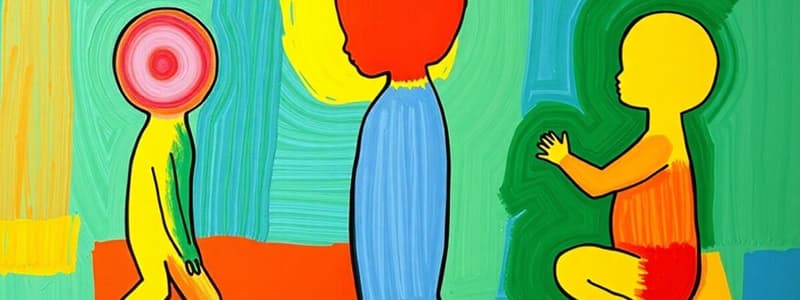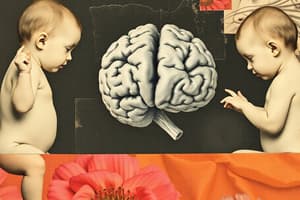Podcast
Questions and Answers
Which neurological structure is MOST responsible for making postural adjustments in response to environmental changes, like walking on an uneven surface?
Which neurological structure is MOST responsible for making postural adjustments in response to environmental changes, like walking on an uneven surface?
- Spinal Cord
- Brainstem
- Somatosensory Cortex
- Basal Ganglia and Cerebellum (correct)
An elderly patient reports increased sway and unsteadiness, particularly when walking with their eyes closed. According to the text, which sensory system is MOST likely impaired?
An elderly patient reports increased sway and unsteadiness, particularly when walking with their eyes closed. According to the text, which sensory system is MOST likely impaired?
- Vestibular (correct)
- Auditory
- Olfactory
- Gustatory
A physical therapist is designing an exercise program for an older adult with decreased postural control. Which spinal change should the therapist consider when selecting exercises?
A physical therapist is designing an exercise program for an older adult with decreased postural control. Which spinal change should the therapist consider when selecting exercises?
- Increased spinal flexibility
- Increased lumbar lordosis
- Increased thoracic kyphosis (correct)
- Decreased cervical curve
Activation of which muscle group is MOST indicative of 'postural tone' during static postural control?
Activation of which muscle group is MOST indicative of 'postural tone' during static postural control?
A patient is preparing to lift a heavy box. Which type of postural control is MOST directly involved in activating postural muscles before the box is lifted?
A patient is preparing to lift a heavy box. Which type of postural control is MOST directly involved in activating postural muscles before the box is lifted?
Which of the following best describes the cephalocaudal progression in motor development?
Which of the following best describes the cephalocaudal progression in motor development?
An infant is able to grasp aCheerio and bring it to their mouth. This skill BEST represents which principle of typical motor development?
An infant is able to grasp aCheerio and bring it to their mouth. This skill BEST represents which principle of typical motor development?
A child demonstrates improved control of their shoulder muscles before gaining control of their hand muscles. This BEST exemplifies which principle of motor development?
A child demonstrates improved control of their shoulder muscles before gaining control of their hand muscles. This BEST exemplifies which principle of motor development?
Which of the following BEST describes the role of primitive reflexes in early motor development?
Which of the following BEST describes the role of primitive reflexes in early motor development?
Postural reactions begin to emerge around 2-3 months of age. What is the MAIN purpose of these reactions?
Postural reactions begin to emerge around 2-3 months of age. What is the MAIN purpose of these reactions?
Which of the following is the MOST likely age range for an infant to achieve independent sitting?
Which of the following is the MOST likely age range for an infant to achieve independent sitting?
A child who is 14 months old is MOST likely demonstrating which gross motor skill?
A child who is 14 months old is MOST likely demonstrating which gross motor skill?
A patient uses visual input to maintain an upright head position when the support surface is unstable. This is BEST described as what type of reaction?
A patient uses visual input to maintain an upright head position when the support surface is unstable. This is BEST described as what type of reaction?
A patient extending their arms forward when falling is an example of which protective reaction?
A patient extending their arms forward when falling is an example of which protective reaction?
Which of the following factors accounts for the LARGEST percentage of the impact of aging on postural control?
Which of the following factors accounts for the LARGEST percentage of the impact of aging on postural control?
Flashcards
Spinal Cord Role
Spinal Cord Role
Sensory input drives motor output for postural control.
Brainstem Role
Brainstem Role
Helps with postural adjustments and anticipatory control.
Basal Ganglia & Cerebellum
Basal Ganglia & Cerebellum
Balance adjusting in changing tasks and environments.
Feedforward Postural Strategies
Feedforward Postural Strategies
Signup and view all the flashcards
Static Postural Control
Static Postural Control
Signup and view all the flashcards
Cephalocaudal Progression
Cephalocaudal Progression
Signup and view all the flashcards
Gross to Fine Motor
Gross to Fine Motor
Signup and view all the flashcards
Proximal to Distal
Proximal to Distal
Signup and view all the flashcards
Reflexive to Volitional Movement
Reflexive to Volitional Movement
Signup and view all the flashcards
Postural Reactions
Postural Reactions
Signup and view all the flashcards
Righting Reactions
Righting Reactions
Signup and view all the flashcards
Optical Righting
Optical Righting
Signup and view all the flashcards
Labyrinthine Righting
Labyrinthine Righting
Signup and view all the flashcards
Protective Reactions
Protective Reactions
Signup and view all the flashcards
Equilibrium Reactions
Equilibrium Reactions
Signup and view all the flashcards
Study Notes
Typical Development Progression
- Cephalocaudal progression refers to when the head learns how to lift itself against the ground before the pelvis into a quadruped position.
- Gross motor skills develop before fine motor skills as kids are able to make big, full body movements with their arms and legs before they develop the grasp movement.
- Proximal musculature control is gained before the distal musculature (works with gross motor before fine motor).
- Reflexive movements develop into volitional movement as the ability to take over with voluntary movement evolves as a function of the individual, task, and environment.
- Infant reflexes transition into postural reactions are controlled from the level of the brain stem to volitional control.
Primitive (Infant) Reflexes
- Movement is linked to reflexes for the first months of life.
- Reflexive movements occur quickly through a stimulus-response.
- Reflexes involve single muscle or specific group of muscles.
- The reflexes are extinguished over the first year of life.
Developmental Postural Reactions
- Righting reactions orient the head in space to keep it upright in midline.
- Optical righting functions in space using visual output.
- Labyrinthine righting functions to an upright position using vestibular input.
- Body on head functions to an upright position using proprioceptive input.
Protective Reactions
- Protective reactions extend the extremities in effort to protect from injury when falling forward, sideways, and backward.
- Known as a parachute response, it allows the arms to catch the body to protect the head when laying prone off a surface or when tipped head first (forward protective extension).
- Backward protective reactions extend the arms backward to protect against backward fall.
Equilibrium Reactions
- Equilibrium reactions occur when the body is displaced off balance, creating a change of posture, causing the trunk and extremities to move in the direction opposite the force that induces the loss of balance.
- Orients whole body to midline and upright position against gravity.
Impact of Aging on Postural Control
- Factors that impact postural control including individual system changes, tasks change, and environments becoming more varied.
- Postural control is dependent upon individual variability, including if they are sedentary vs active, ability to perform tasks, and history of falls.
- Internal (primary) factors for postural control depend on genetics and family history, and account for 20% of aging impact.
- External (secondary) factors include lifestyle & environmental factors, which account for 80% of aging impact.
- Decline in vestibular, visual, and somatosensory functioning may lead to decreased postural control and may increase risk of falling.
- Decreased spinal flexibility and muscle strength lead to increased cervical curve, thoracic kyphosis, & flattened lumbar spine, leading to forward weight shift.
- Muscle strength peaks in 20s/30s then begins to decline as one ages.
- Sarcopenia development is associated with loss of function & decreased postural control; muscles used for running/jumping atrophy faster than muscles for walking/daily tasks.
- The loss of neurons, dendrites, synapses, neurotransmitters, & myelin in aging causes slower processing speed and delayed postural reactions.
Four Types of Postural Control
- Static control involves little conscious muscle activation.
- Postural tone is the activation by antigravity postural muscles to keep upright and in good alignment, including the erector spinae, abdominals, TFL, gastrocnemius, tibialis anterior.
- Anticipatory/Adaptive Control Feedforward postural strategies engage postural muscles activated in advance based off what the person anticipates.
- Reactive/Adaptive Control Feedback postural control consists of muscle synergies that are used to regain postural control in ant/post loss of balance.
- The ankle strategy is used for slower and smaller perturbations.
- The hip strategy is used for faster and larger perturbations.
- The stepping strategy changes the support surface when ankle & hip strategies aren't enough to maintain BOS.
- Reach & grasp may be used as alternative strategy instead of stepping strategy for medial/lateral loss of balance.
- Lateral movement at pelvis: adduction of one leg, abduction the other.
- Head movement starts the correction, followed by the rest of the body (cephalocaudal).
Studying That Suits You
Use AI to generate personalized quizzes and flashcards to suit your learning preferences.




